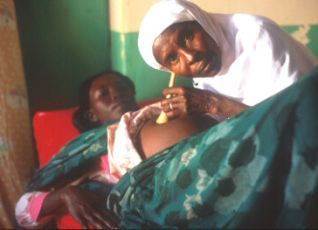Maternal mortality continues to increase in southern Sudan
By Ngor Arol Garang
September 13, 2010, (MELUT) — While the semi-autonomous regional Government of Southern Sudan (GoSS) puts in place efforts to reduce the maternal mortality rate, reports continue to indicate that it is soaring across the region.

During the civil war the Sudan People’s Liberation Army / Movement (SPLA/M) controlled areas had medical facilities run by international relief and humanitarian organizations. However, some of them pulled out immediately after cessation of hostilities between the SPLA and Sudan Armed Forces, leaving areas they served vulnerable to diseases.
The GoSS’ Ministry of Health report indicates that maternal mortality rate within the stipulated period was high among poor women in rural communities due to inadequate access to quality obstetric care, with only 13% of births in rural areas assisted by qualified staff from international relief and humanitarian organizations.
The Minister of Health, Luka Monoja Tombe, spoke in a participatory meeting held by the directorate of primary health care and preventive services – a day-long meeting which became a platform for players in the health care delivery services, in which they presented their respective researches and brainstormed areas which have a direct impact on the region’s development.
The meeting was attended by doctors, physicians, dentists and other health professionals who explained that 15% of maternal deaths occur due to unpredictable complications in pregnancy and childbirth.
Tombe stated that increased access to skilled practitioners at birth could reduce maternal deaths, by about 70%.
Tombe disclosed the out of less than 13,971 health practitioners in the region, most of whom are nurses and midwives, less than 200 practice midwifery and more than 50% are over 50 years of age.
Noting that an additional 1000 midwives were needed to fill the existing gap, Tombe said there are plans for a midwifery college to be established in the region.
Tombe added that although pregnancy and childbirth are times of joy for parents and their families in the advanced countries, in developing countries it is a time of great risk.
A United Nations Children’s Fund (UNICEF) report indicates that around 1,500 women die every day in the world, especially developing countries, from complications related to pregnancy and childbirth.
Although world leaders resolved in 2000 to reduce maternal mortality rates by three quarters in by 2015, in fulfillment of one of United Nation’s Millennium Development Goals, not much has changed.
Tombe stressed the need for health workers to put their services at the disposal of those who need them most.
“It is crucial that we make a declaration and commitment to put service above self and collaborate vigorously with our partners to promote health delivery system for our people and community,” he observed.
Tombe thanked all and who contributed in diverse ways in to the meeting, pledging that the gathering will continue to be staged regularly.
(ST)
